Development of a Design Catalog for Bonded Concrete Overlay Pavements Considering the Regional Characteristics of Korea
Abstract
:1. Introduction
2. Determination of New Pavement Slab Thickness Data Collection
3. Development of a Finite Element Analysis Model
3.1. Determination of Input Values of the Finite Element Analysis
3.2. Calculation of the Stress–Strength Ratio
4. Development of a Design Catalog for BCO Pavement
5. Comparison of Results
6. Conclusions
- In this study, a mechanistic–empirical design catalog for BCO pavements was developed considering the unique Korean climate, pavement material, and traffic conditions. First, the representative thickness of a new pavement slab for the region with the worst climatic conditions in Korea was determined according to the traffic volume using the Korean pavement design method. The range of representative thicknesses for a new pavement slab in Korea was determined to be 200–330 mm.
- FEA models simulating new jointed concrete and BCO pavements were developed using the structural and material characteristics of Korean pavements as input values. The range used in the FEA model for a new pavement slab thickness was 200–330 mm, according to the results of the Korean pavement design program. The range of existing pavement slab thickness was 130–300 mm when using a milling depth of 30–70 mm, which is commonly used in the field. The range of the BCO thickness was determined to be 50–150 mm after comprehensively considering previous studies and Korean construction cases.
- The maximum tensile stress at the bottom of a new pavement slab was obtained by an FEA, in addition to that at the bottom of an existing slab according to its elastic modulus, thickness after milling, and BCO thickness. The BCO thickness was determined by adjusting it until the stress–strength ratio at the bottom of an existing slab of BCO pavement was the same as that at the bottom of a new pavement slab. The procedure was repeated according to the elastic modulus and thickness of the existing slab after milling, and the traffic volume was used to develop the BCO design catalog.
- The BCO thickness designed by the catalog developed in this study was compared with that designed using the PCA chart. The PCA chart can be used after designing the new concrete pavement, whereas the design catalog can be used by merely considering the traffic volume without designing a new pavement. Consequently, the BCO designed by the catalog in this study was slightly thicker than that designed by the PCA method.
- Most of the BCO thicknesses of the LTPP sections in the US were similar to the minimum BCO thicknesses designed using the catalog in this study. As a result, it was verified that the BCO thickness of the LTPP sections was more conservatively redesigned by the catalog in this study because it corresponded to a new pavement slab, which was conservatively designed by the Korean pavement design method for a region with the worst climatic conditions. In addition, the traffic and material conditions considered in the Korean pavement design method could contribute to the conservative design of this study.
- A more reasonable design of BCO pavements considering the Korean climate, pavement material, and traffic conditions can be performed using the design catalog developed in this study. In addition, catalog design of BCO thickness will also be possible for other countries by considering their own regional climate, traffic, and material conditions.
Author Contributions
Funding
Institutional Review Board Statement
Informed Consent Statement
Data Availability Statement
Acknowledgments
Conflicts of Interest
References
- MOLIT. Status on Road Repair and Maintenance; Ministry of Land, Infrastructure, and Transport: Sejong, Korea, 2016.
- Lee, J.-H.; Kim, D.-H.; Moon, K.-H.; Falchetto, A.C.; Kim, J.-C.; Jeong, J.-H. Development of representative section selection method for large-scale concrete pavement remodeling project based on trial and error correction approach. Int. J. Pavement Res. Technol. 2019, 12, 17–25. [Google Scholar] [CrossRef]
- Kim, D.-H.; Lee, J.-M.; Moon, K.-H.; Park, J.-S.; Suh, Y.-C.; Jeong, J.-H. Development of Remodeling Index Model to Predict Priority of Large-Scale Repair Works of Deteriorated Expressway Concrete Pavements in Korea. KSCE J. Civ. Eng. 2019, 23, 2096–2107. [Google Scholar] [CrossRef]
- Kim, Y.K.; Lee, S.W. Performance evaluation of bonded concrete overlay. Constr. Build. Mater. 2013, 49, 464–470. [Google Scholar] [CrossRef]
- Texas DOT. Pavement Manual; Texas Department of Transportation: Austin, TX, USA, 2021.
- AASHTO. Guide for Design of Pavement Structures; American Association of State Highway and Transportation Officials: Washington, DC, USA, 1993. [Google Scholar]
- MOLTMA. Development of Korea Pavement Research Program and Research: Design of Pavement Performance Improvement System; 2nd Phase 4th Year Final Report; KPRP-H-08; Ministry of Land, Transport and Maritime Affairs: Sejong, Korea, 2010.
- MOLIT. Standard Specification of Road Construction; Ministry of Land, Infrastructure and Transport: Sejong, Korea, 2015.
- MOLTMA. Road Pavement Structure Design Guideline; Ministry of Land, Transport and Maritime Affairs: Sejong, Korea, 2011.
- MOLIT. 2018 Yearbook of Road Traffic Volume; Ministry of Land, Infrastructure, and Transport: Sejong, Korea, 2019.
- KEC. Standard Drawings for Expressway Construction; Korea Expressway Corporation: Gimcheon, Korea, 2018. [Google Scholar]
- Jung, K.S.; Kim, I.T.; Ryu, S.W.; Cho, Y.H. Development of Stress Equations of Jointed Concrete Pavement Using Finite Element Method. Int. J. Highw. Eng. 2008, 10, 167–181. [Google Scholar]
- Westergaard, H.M. New Formulas for Stresses in Concrete Pavements of Airfields. Trans. Am. Soc. Civ. Eng. 1948, 113, 425–439. [Google Scholar] [CrossRef]
- Lu, L.-W.; Ricles, J.; Mao, C.; Fisher, J.W. Critical issues in achieving ductile behaviour of welded moment connections. J. Constr. Steel Res. 2000, 55, 325–341. [Google Scholar] [CrossRef]
- Ricles, J.; Mao, C.; Lu, L.-W.; Fisher, J.W. Inelastic Cyclic Testing of Welded Unreinforced Moment Connections. J. Struct. Eng. 2002, 128, 429–440. [Google Scholar] [CrossRef]
- Kim, D.H.; Ma, G.H.; Park, H.W.; Jeong, J.H. Development of Maximum Tensile Stress Prediction Model for Airport Concrete Pavements Using Environmental and B777 Aircraft Gear Loadings. Int. J. Highw. Eng. 2018, 20, 93–102. [Google Scholar] [CrossRef]
- Park, H.-W.; Kim, D.-H.; Lim, J.-S.; Shim, C.-S.; Jeong, J.-H. Prediction of differential drying shrinkage of airport concrete pavement slabs. Int. J. Pavement Eng. 2021, 22, 752–762. [Google Scholar] [CrossRef]
- Tayabji, S.D.; Okamoto, P.A. Thickness Design of Concrete Resurfacing. In Proceedings of the Third International Conference on Concrete Pavement Design and Rehabilitation, West Lafayette, IN, USA, 23–25 April 1985; pp. 367–379. [Google Scholar]
- KCSC. Bonded Concrete Overlay Pavement Standard Specification; KCS 44 99 10; Korea Construction Standards Center, Ministry of Land, Infrastructure, and Transport: Sejong, Korea, 2016.
- Son, H.J. Evaluation of the Performance of Overlay Methods on Aged Concrete Pavement. Master’s Thesis, Gangneung-Wonju National University, Gangneung, Korea, 2011. [Google Scholar]
- Park, J.W.; Kim, Y.K.; Han, S.H.; Lee, S.W. Feasibility Study of AASHTO86 Design Method for Bonded Concrete Overlay. Int. J. Highw. Eng. 2013, 15, 47–55. [Google Scholar] [CrossRef]
- Huang, Y.H. Pavement Analysis and Design, 2nd ed.; Pearson Prentice Hall: Upper Sad River, NJ, USA, 2004. [Google Scholar]
- Kim, Y.K.; Lee, S.W.; Kyu, K.Y.; Woo, L.S. Service life of bonded concrete overlay. Proc. Inst. Civ. Eng. -Transp. 2015, 168, 267–275. [Google Scholar] [CrossRef]


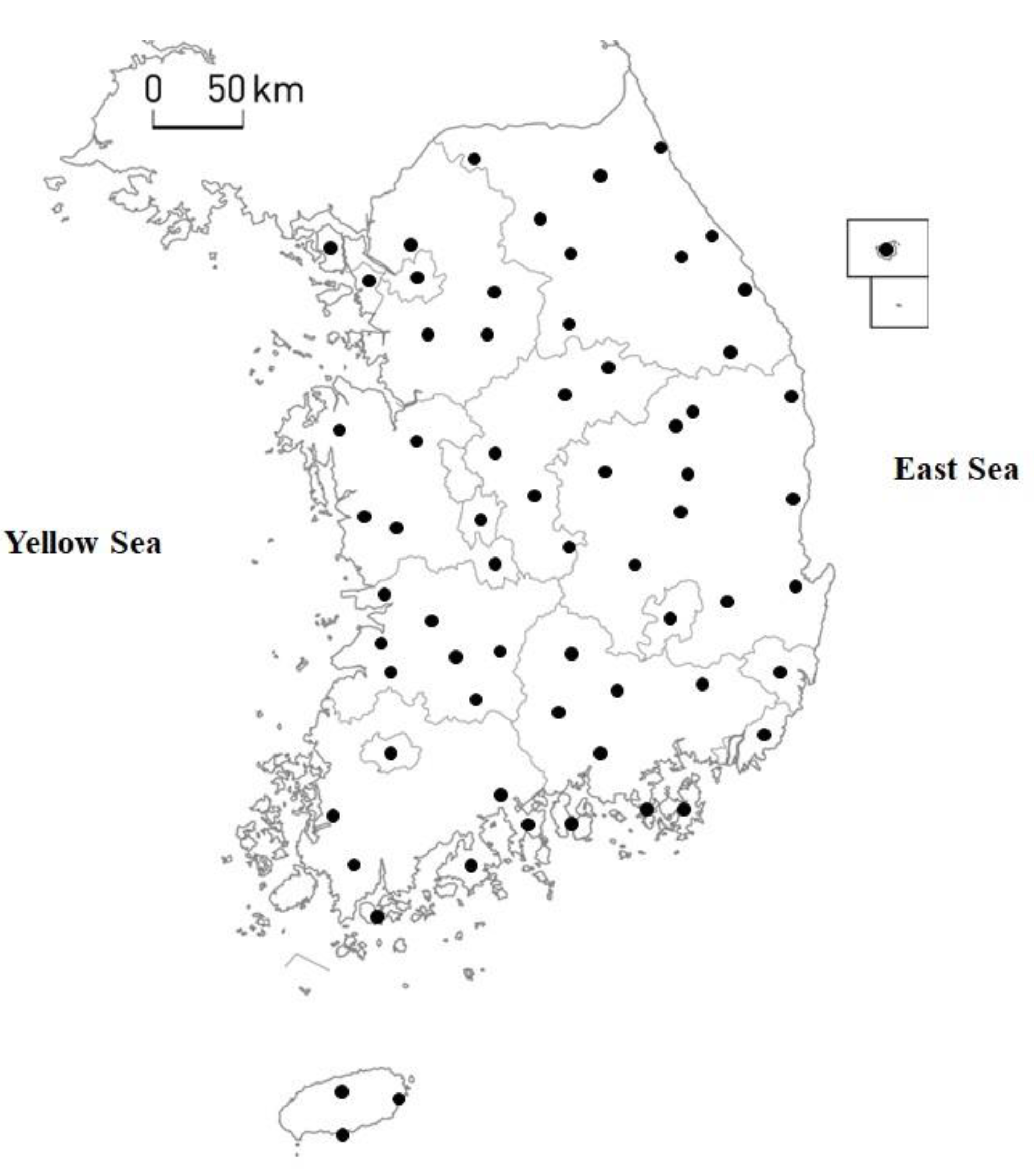
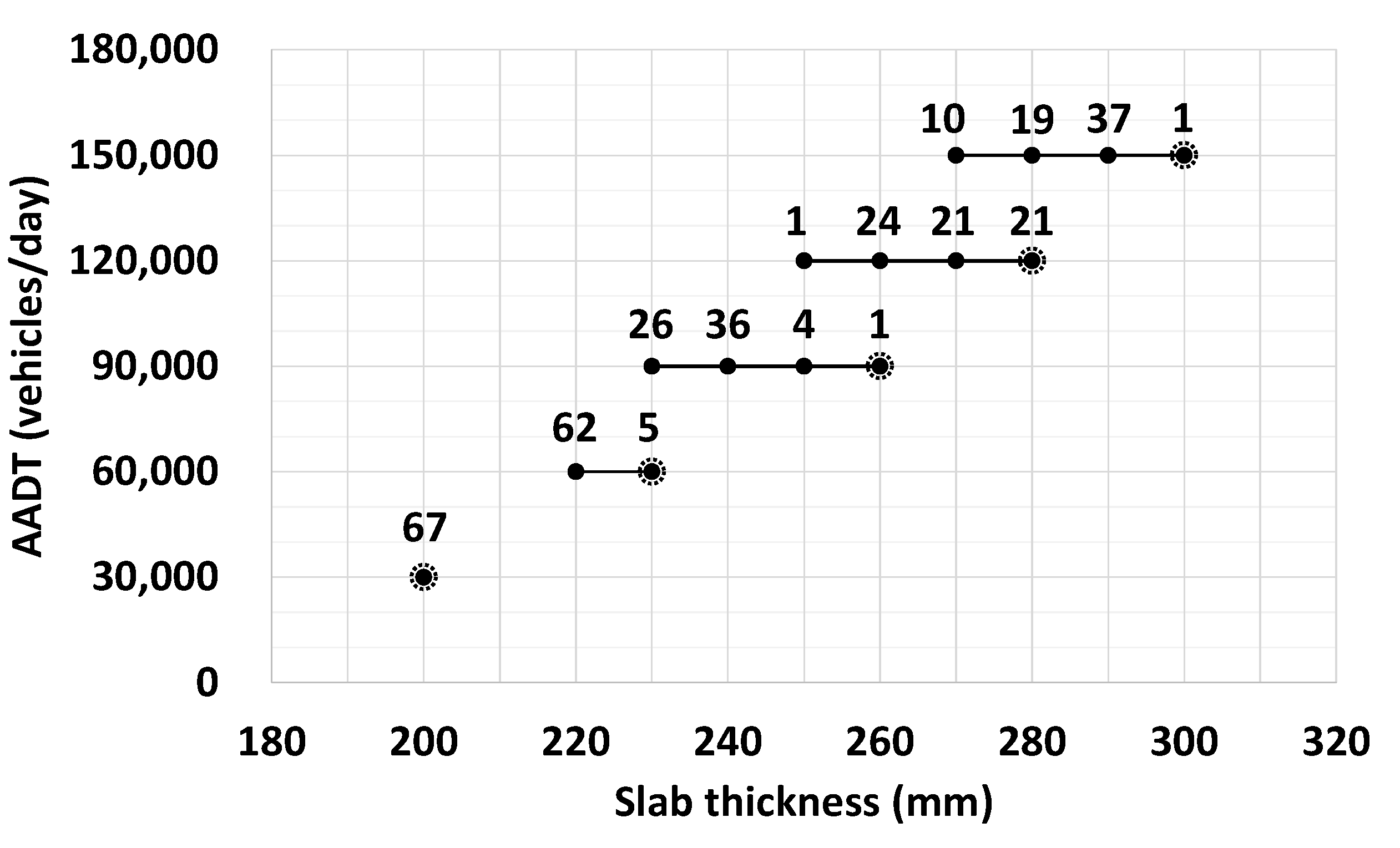
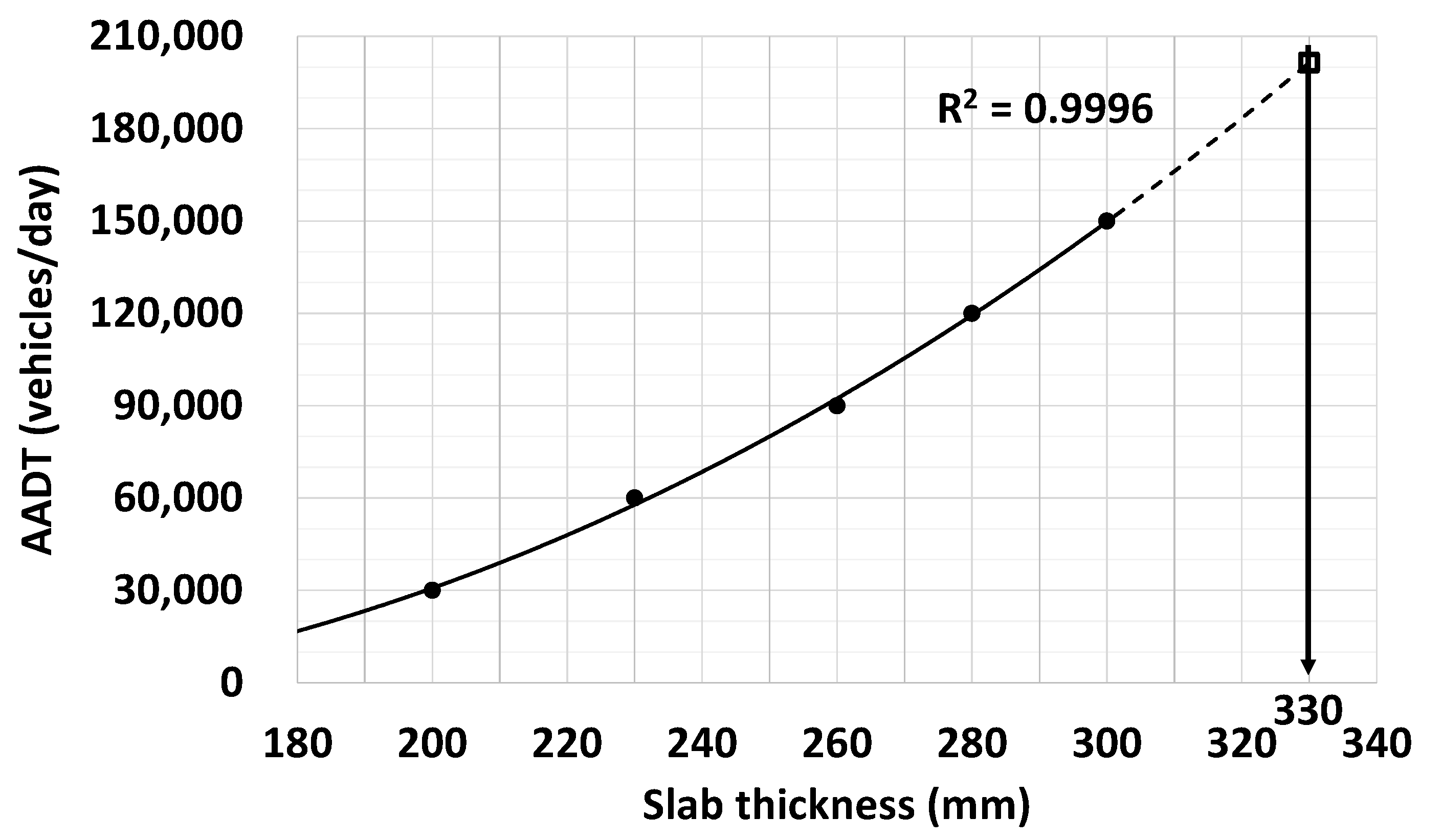

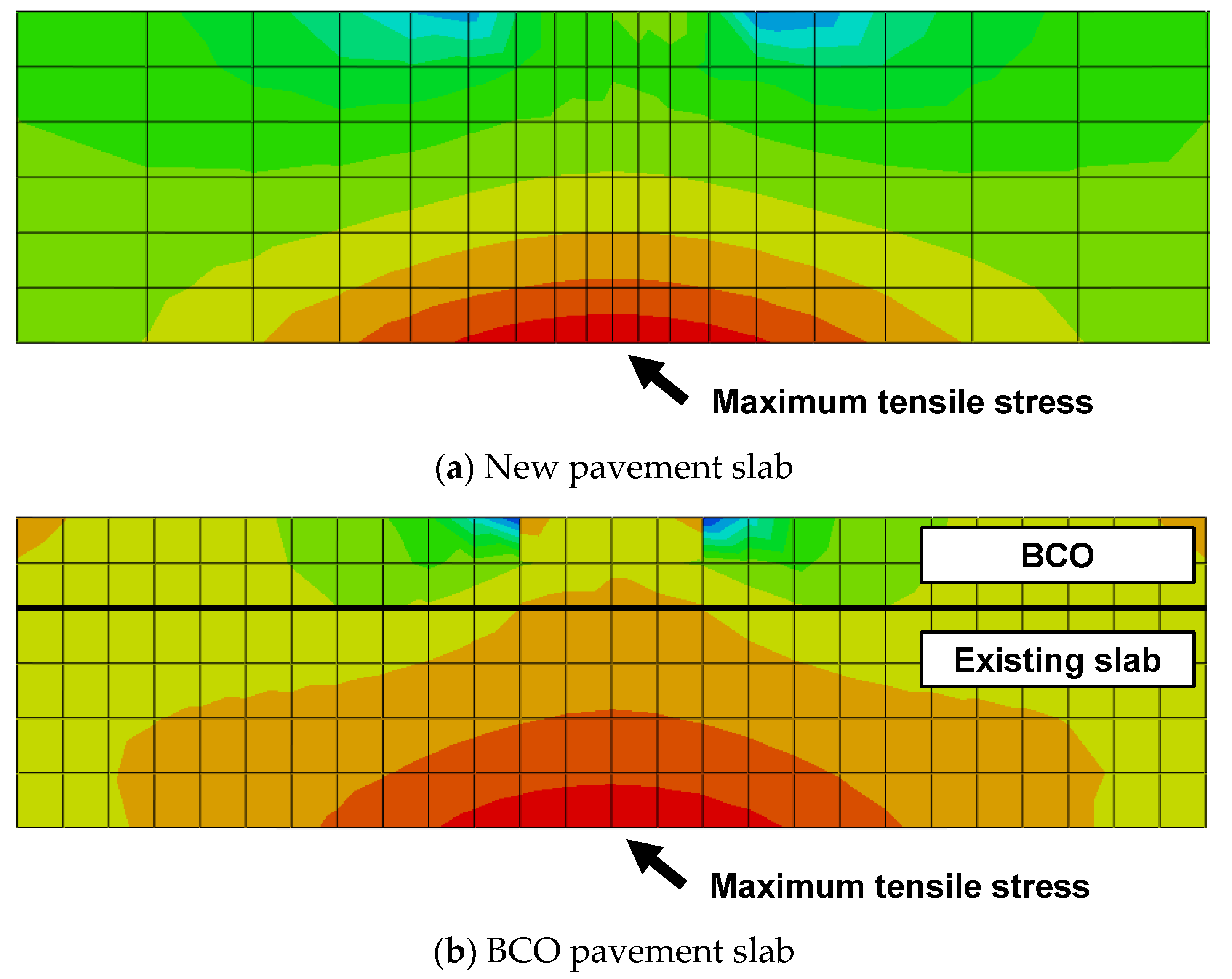
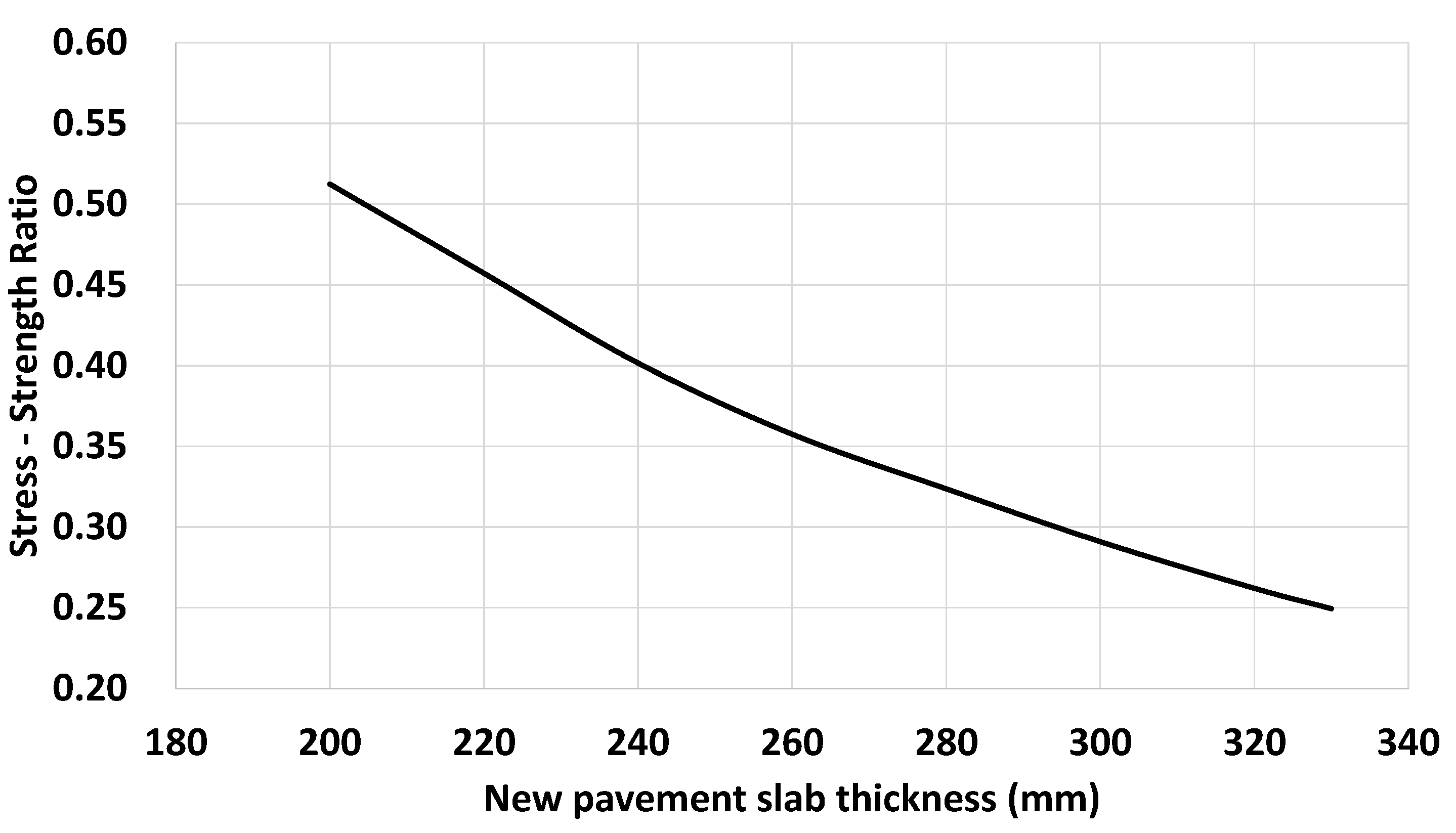

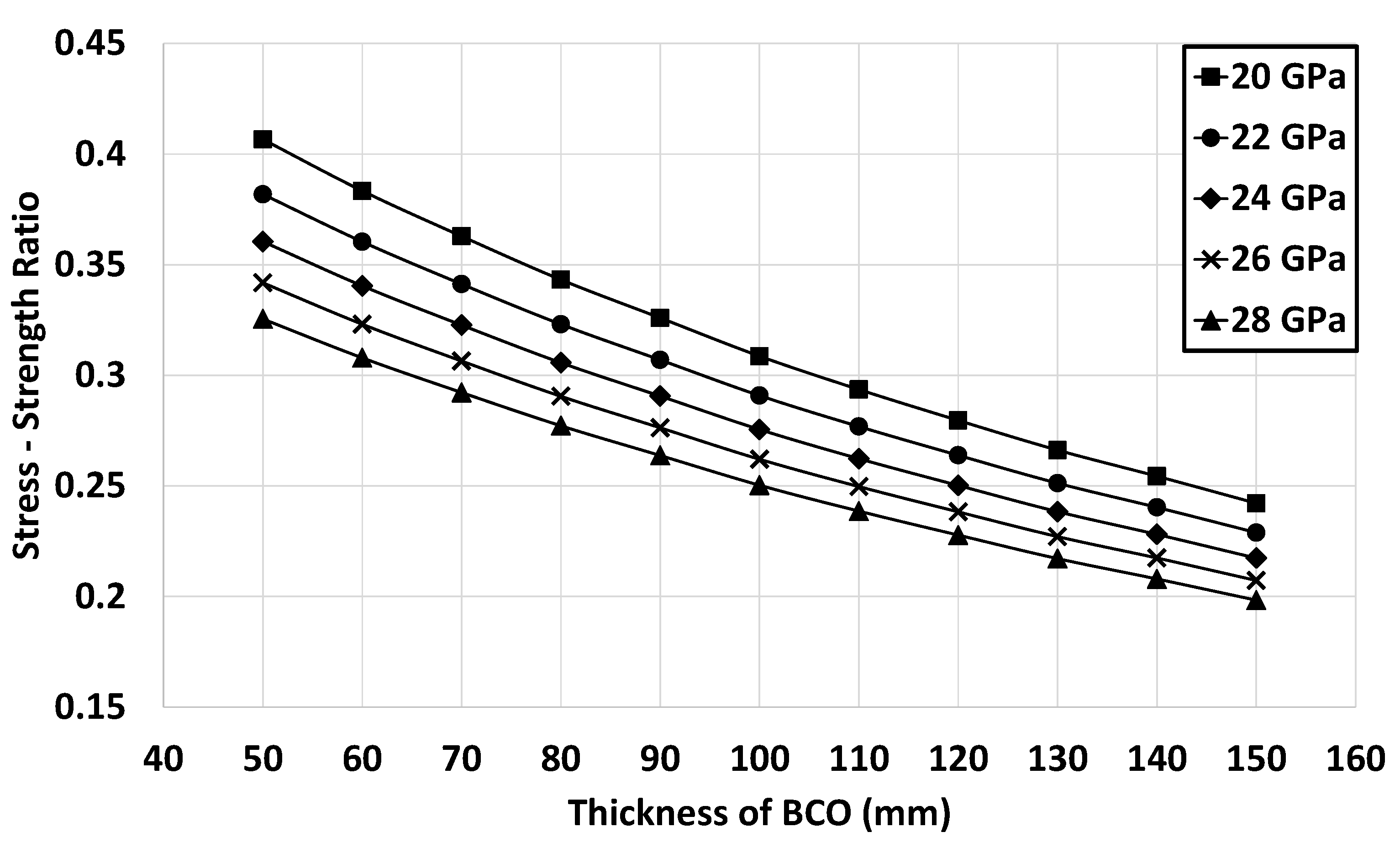
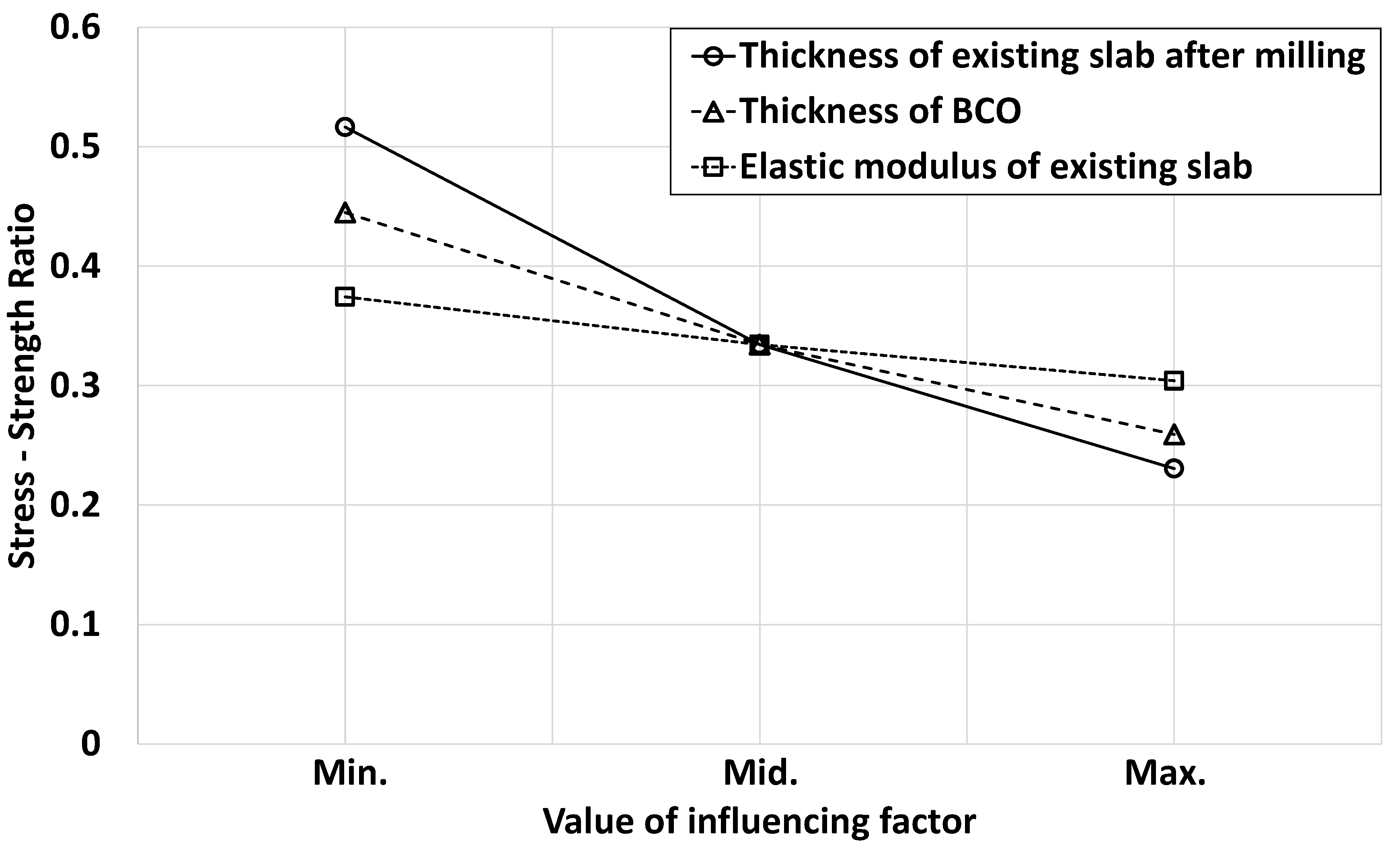
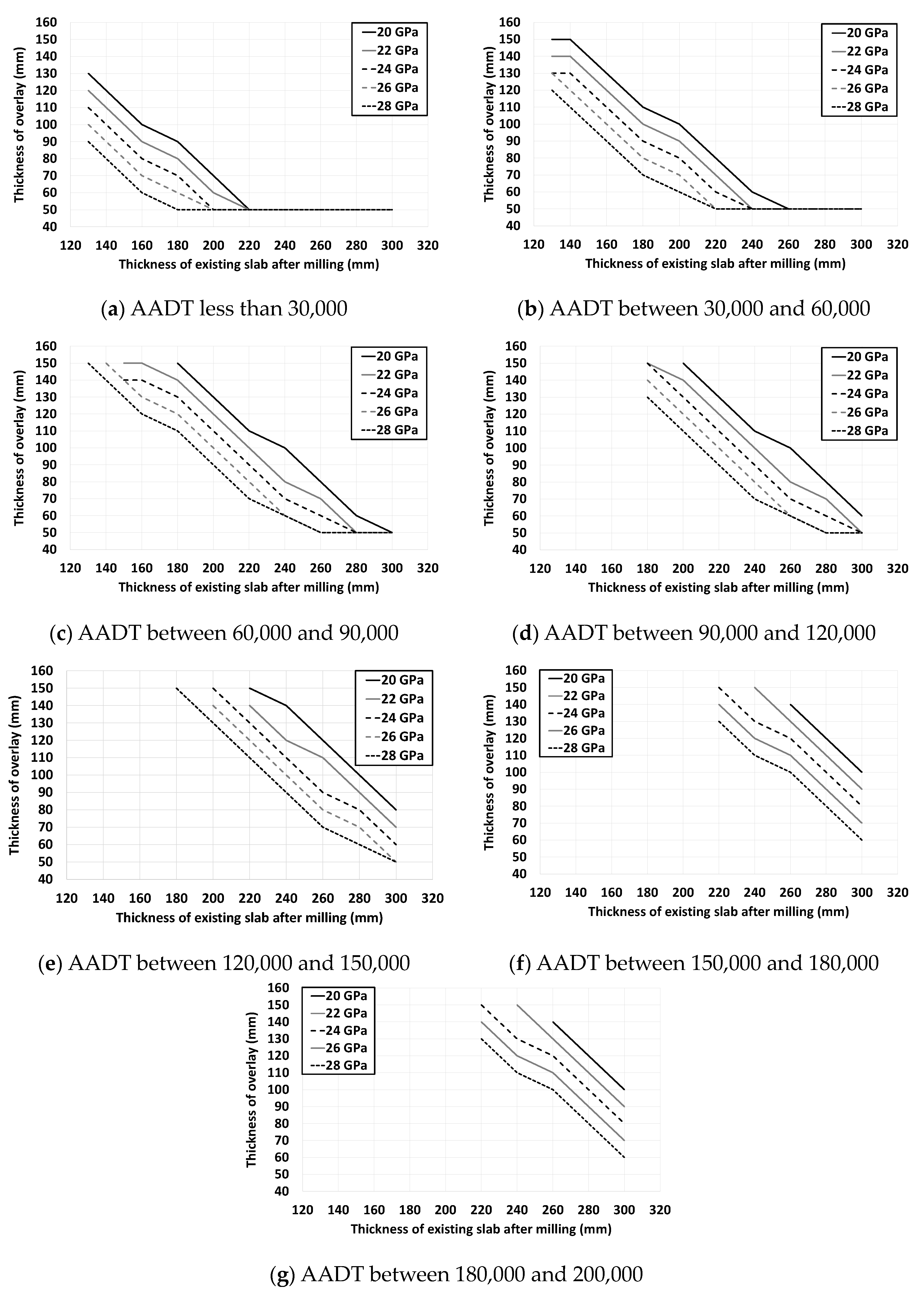
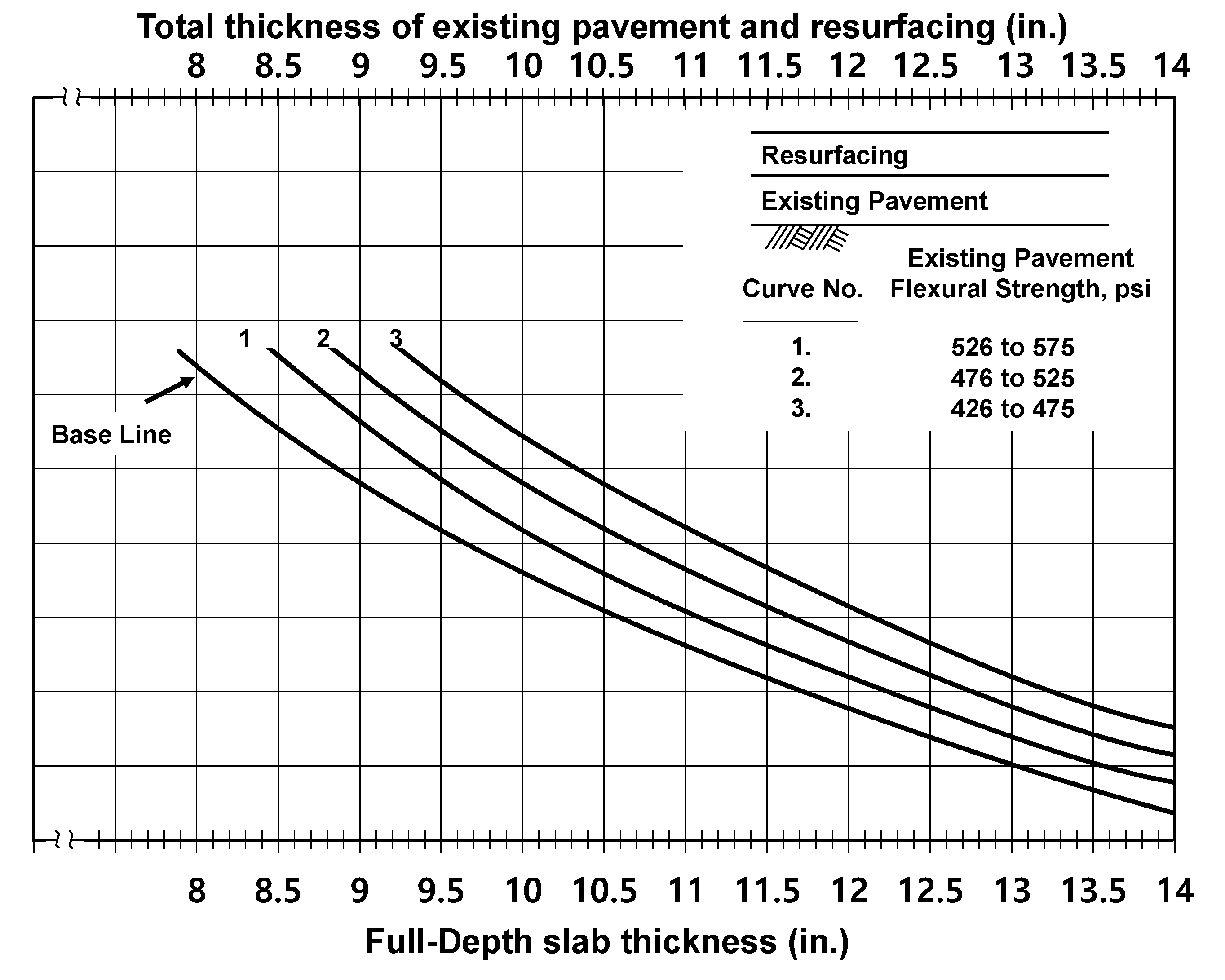


| Design Level | Road Type | AADT (Vehicles/Day) | Remark |
|---|---|---|---|
| 1 | Expressway | >150,000 | >50,000 of heavy vehicles (Type 5 or Over) |
| National highway | >35,000 | >12,000 of heavy vehicles (Type 5 or Over) | |
| 2 | Expressway | ≥150,000 | - |
| National highway | 35,000 ≥ AADT > 7000 | - | |
| Local roads and other roads | ≥7000 | - | |
| 3 | National highway, local roads, and other roads | >7000 | - |
| Influencing Factor | Minimum | Medium | Maximum |
|---|---|---|---|
| Thickness of existing slab after milling (mm) | 130 | 220 | 300 |
| Thickness of BCO (mm) | 50 | 100 | 150 |
| Elastic modulus of existing slab (GPa) | 20 | 24 | 28 |
| Input Parameter | Minimum | Maximum |
|---|---|---|
| Thickness of new pavement slab (mm) | 200 | 330 |
| Elastic modulus of existing slab (GPa) | 20 | 28 |
| Thickness of existing slab after milling (mm) | 130 | 300 |
| Thickness of BCO (mm) | 50 | 150 |
| No. | Existing Pavement Type | Existing Slab Thickness after Milling (mm) | Effective Thickness of Existing Slab (mm) | Total Target Thickness of Slab (mm) | BCO Thickness (mm) | BCO Thickness (This Study) (mm) | |
|---|---|---|---|---|---|---|---|
| Min. | Max. | ||||||
| 1 | CRCP | 200 | 170 | 270 | 100 | 110 | 150 |
| 2 | CRCP | 200 | 170 | 330 | 160 | >150 | >150 |
| 3 | CRCP | 200 | 170 | 300 | 130 | 130 | >150 |
| 4 | CRCP | 200 | 170 | 310 | 140 | >150 | >150 |
| 5 | CRCP | 190 | 160 | 250 | 90 | 100 | 140 |
| 6 | CRCP | 210 | 180 | 280 | 100 | 100 | 140 |
| 7 | CRCP | 200 | 170 | 320 | 150 | >150 | >150 |
| 8 | CRCP | 210 | 180 | 330 | 150 | >150 | >150 |
| 9 | CRCP | 190 | 160 | 300 | 140 | 140 | >150 |
| 10 | CRCP | 190 | 160 | 250 | 90 | 100 | 140 |
| 11 | CRCP | 210 | 180 | 260 | 80 | 80 | 120 |
| 12 | CRCP | 200 | 170 | 300 | 130 | 130 | >150 |
| 13 | CRCP | 200 | 170 | 300 | 130 | 130 | >150 |
| 14 | CRCP | 180 | 150 | 290 | 140 | 150 | >150 |
| 15 | CRCP | 200 | 170 | 290 | 120 | 130 | >150 |
| 16 | JPCP | 190 | 160 | 260 | 100 | 100 | 140 |
| 17 | JPCP | 200 | 170 | 250 | 80 | 90 | 130 |
| 18 | JPCP | 210 | 180 | 270 | 90 | 100 | 140 |
| 19 | JPCP | 210 | 180 | 260 | 80 | 80 | 120 |
| 20 | JPCP | 210 | 180 | 320 | 140 | >150 | >150 |
| 21 | JPCP | 210 | 180 | 300 | 120 | 120 | >150 |
| 22 | JPCP | 200 | 170 | 290 | 120 | 130 | >150 |
| 23 | JPCP | 200 | 170 | 300 | 130 | 130 | >150 |
| 24 | JPCP | 200 | 170 | 270 | 100 | 110 | 150 |
Publisher’s Note: MDPI stays neutral with regard to jurisdictional claims in published maps and institutional affiliations. |
© 2021 by the authors. Licensee MDPI, Basel, Switzerland. This article is an open access article distributed under the terms and conditions of the Creative Commons Attribution (CC BY) license (https://creativecommons.org/licenses/by/4.0/).
Share and Cite
Park, H.-W.; Seo, J.-S.; Lee, J.-H.; Jeong, J.-H. Development of a Design Catalog for Bonded Concrete Overlay Pavements Considering the Regional Characteristics of Korea. Sustainability 2021, 13, 9876. https://doi.org/10.3390/su13179876
Park H-W, Seo J-S, Lee J-H, Jeong J-H. Development of a Design Catalog for Bonded Concrete Overlay Pavements Considering the Regional Characteristics of Korea. Sustainability. 2021; 13(17):9876. https://doi.org/10.3390/su13179876
Chicago/Turabian StylePark, Hae-Won, Jin-Seok Seo, Jae-Hoon Lee, and Jin-Hoon Jeong. 2021. "Development of a Design Catalog for Bonded Concrete Overlay Pavements Considering the Regional Characteristics of Korea" Sustainability 13, no. 17: 9876. https://doi.org/10.3390/su13179876
APA StylePark, H.-W., Seo, J.-S., Lee, J.-H., & Jeong, J.-H. (2021). Development of a Design Catalog for Bonded Concrete Overlay Pavements Considering the Regional Characteristics of Korea. Sustainability, 13(17), 9876. https://doi.org/10.3390/su13179876






